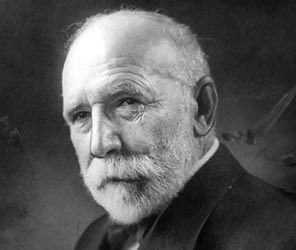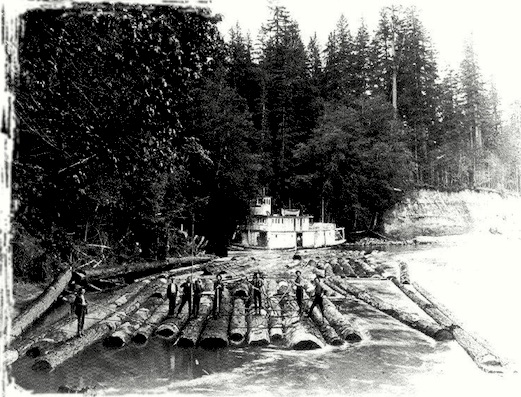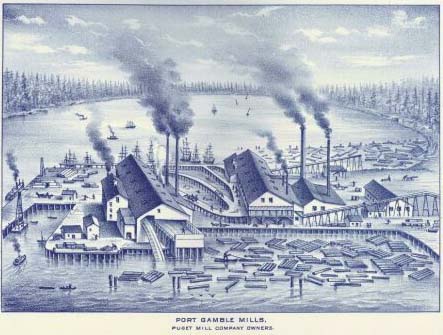Early Washington and the Logging and Timber Industry
Dan Bryan, June 11 2012
It is difficult to imagine the development of Seattle and the rest of Washington without the presence of the logging industry. It didn't take long for the California Gold Rush to expose the need for a steady, good supply of lumber. Starting in the 1850s, the area around the Puget Sound served this need. For a hundred years, no other industry came close to matching logging in its importance to Washington.
Many forests were nearly destroyed by heedless practices during those early years. Encouraged by Gifford Pinchot of the U.S. Forestry Service, and by the Weyerhaeuser Timber Company, compromises were gradually reached with an eye towards sustainable timber harvesting. Simultaneously preserving the forest and profiting from it is a tension that has defined Washington ever since.
The rough world of Washington logging towns
During the first decades of significant settlement, logging was very much a small organization enterprise. Often a few men would set up a site near the shore of Puget Sound, cut down all of the surrounding trees, and overload the closest ship for transport to California. Transport by any means other than boat was difficult in the back-country. Towns remained small, and the culture of the logging men was libertine and suffused with machismo.
No town of any size existed without a saloon. With little else to spend their money on, men congregated to gamble, drink, fight, and carouse with prostitutes. There were few white women, so most of the hookers were native Indians or Asian women.
While logging also occurred in Oregon, the cultural effects were mitigated there by the presence of numerous farming families, who brought something of a check to the excesses of taverns and prostitution. In Washington, the loggers had the place to themselves for many years, and the area gained its reputation as a den of vice and lawlessness. Few outsiders dared venture into some of the towns.
Most notorious were the cities around Grays Harbor, such as Aberdeen and Hoquiam. In a single year over forty dead bodies were found floating in the water under varying circumstances. Billy Gohl was credited with many of the murders, as well as innumerable assaults, thefts, and arsons. Part-time psychopath, part-time bartender and union agent, he took a special delight in targeting sailors at liberty.
Labor Radicalism and the IWW
Labor radicalism entrenched itself more firmly in Washington than in most parts of the country. Logging was a dangerous, grisly profession. With automated saws, falling trees weighing several tons, and other such features, the death and dismemberment rate was atrocious. Hardly any man escaped the minor cuts and muscle strains that came with the job.
Attempts to unionize were sporadic and inconsistent, but the possibility was always lurking. Business owners employed all of the usual tricks to fight this process -- firing suspected organizers, infiltrating union meetings with spies, attacking demonstrations, and so on.
In 1907 a new threat emerged to the business classes, across the Colombia River in Portland. All of the sawmills in that town were shut down for several weeks by a radical group called the Industrial Workers of the World. No ordinary union, their avowed goal was to overthrow capitalism entirely and replace it with public land distribution, collective factory ownership, and all the other taboos of American political discourse.
The IWW (aka "Wobblies") began to organize and find support among the Washington loggers, to the horror of most respectable citizens. Combating their influence became a priority.
Forest fires and depletion
"Sustainability" was not even a word in the 1800s. The first lumbermen who operated cut down anything they could get their hands on, limited only by the problems of transportation into the interior of the land. Soon the ugly sights of clear cut forests and muddy hills were commonplace in the area around the Sound.
Forest fires were rampant. A few were even lit by locals to celebrate important events, as a type of festivity. More trees were burned down than cut down over the first few decades of logging, and it was commonplace for Seattle and Tacoma to be covered in a haze of smoke that wafted from the surrounding hills. Ships navigating the Juan de Fuca straight with loads of timber sometimes found themselves unable to see more than a few feet into the horizon.
One of the worst fires occurred in 1902 -- the Yacolt Burn. Starting between Mount St. Helens and the Colombia River, it burned over 200,000 acres and killed over 30 people. 12 billion board feet of timber were lost.
In the aftermath, there was both state and federal concern over the consequences. Teddy Roosevelt -- a fervent naturalist himself -- was appalled. Even those who operated entirely from a business mindset could see how much valuable timber had been torched. Roosevelt's good friend Gifford Pinchot, chief of the U.S. Forest Service, would become a central figure in Washington business and politics over the early years of the 1900s.
Weyerhaeuser Timber Company
On January 3, 1900, the timber industry in Washington underwent one of the biggest changes in its history. On that day, Midwestern lumber magnate Frederick Weyerhaeuser purchased 900,000 acres of land from the Northern Pacific railroad in the largest private land transaction in American history to that point in time. He paid $6 an acre.
 Frederick Weyerhaeuser
Frederick WeyerhaeuserWeyerhaeuser's company brought economies of scale that modernized the industry. Part of the company's deal with Northern Pacific give it low rates on shipments to the eastern markets. At the same time, the formerly thriving lumber industry of Wisconsin and Minnesota was in decline, due to deforestation. Thus, the national prominence of the Pacific Northwest timber industry was ensured.
Worker's compensation laws
Weyerhaeuser did not take a hard line on wages and working conditions. He came more from the tradition of those who saw value to good morale and decent pay, though of course his employees may not have always agreed with that statement.
The issue of injuries and deaths on the job was central. The dangers came from being cut and crushed, and the protections and compensation were inconsistent. However, some workers brought suits in state court and were awarded large sums. Many companies maintained that workers routinely ignored safety measures and were frightened by the size of the judgments.
In any event, a compromise was reached. Working with the American Federation of Labor, the largest timber companies including Weyerhaeuser's drafted a worker's compensation law, which was implemented in 1911. Thus, Washington joined the first wave of states to establish such programs.
While the labor situation in the area remained volatile, groups like the Wobblies never gained the influence that they aspired to.
Forest management
Working for the U.S. Forest Service, Gifford Pinchot achieved much of his reform agenda in the state of Washington. While their agreement on every issue was not ironclad, Pinchot found an ally in Weyerhaeuser. In the great 1902 fire, numerous acres of Weyerhaeuser's timberland had burned. He was therefore eager for some authority to establish greater control over the forest and prevent such expensive calamities.
The amount of area that was placed under federal protection was increased drastically. 7.4 million acres were protected in federal reserves by 1905. On top of providing environmental benefits to the region, this helped Weyerhaeuser and other established firms by reducing the amount of competition, and by increasing the value of that timber which was harvested.
New forestry regulations and organizations were also created, much of them at the behest of Weyerhaeuser, and with the support of Pinchot. George Long, the company's long-time manager in Washington, helped to draft much of the legislation which allowed for forest patrols, a state forest commission, a burning permit system, and a forestry school at the University of Washington. All of these were passed between 1900 and 1910.
Additionally, the practice of total deforestation was largely replaced with the selective harvesting of commercially viable trees from a given area. The rest of the trees remained as forest cover, with the expectation that they would grow into usable timber over time. Eventually this method revealed its own problems, but for the time it was a huge improvement over the exploitative practices in place.
A case of pragmatic compromise
Overall, the experience of Washington state is an example of pragmatic compromise reached in the interests of large business, mixed with concessions for other classes of society. In other words, an example of the larger American system applied to a particular locale.
This is not to naively state that everyone was happy with the results (indeed, one of the most contentious strikes in American history happened in Seattle in 1919), but to state that the overall agenda worked as well as could be expected of such an enterprise. If the goal was to preserve a lumber industry in the northwest, and to avoid the fate that befell Wisconsin and other places, then it seems to have been a success.



